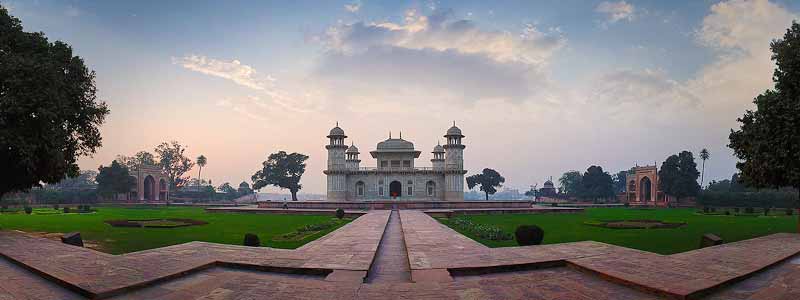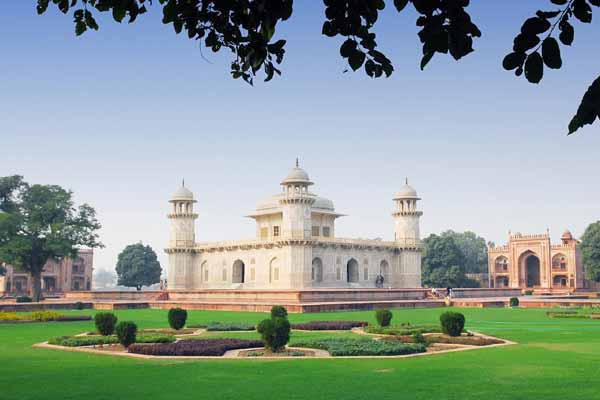Tomb of Itimad ud Daulah is a mausoleum built of white marble, which also consists of premises featuring luxurious gardens and composite buildings. The monument is situated upon a large garden. Around it are numerous water streams and pathways, and is contrasted with the surroundings. The structure consists of the main central build placed upon a red sandstone platform, and has a six sided minar on each of the four corners Agra Tourism.
The exterior of the walls have marbles bearing embedded gems and rare precious stones such as the cornelian, lapis lazuli, onyx, jasper, topaz, etc., which are arranged into exquisite patterns of cypress trees, wine holders, flower boutiques and fruit designs. The walls look stunning by grace of the “jail” technique due to which light penetrates through them. Varieties of mesmerizing tones and shades of multicoloured gems have been used in the making.
The verdant gardens of the Tomb of Itimad ud Daulah draw visitors from across the world, no surprise that Itmad-ud-daulah Tickets sell like hot bricks! Tickets for Itmad-ud-daulah can be hard to behold so it is a good idea to buy tickets for Itmad-ud-daulah in advance or contemplate tours that offer a good deal on Itmad-ud-daulah ticket prices. To know more check out our tickets section.

History of Itimad-Ud-Daulah
Tomb of Itimad ud Daulah has a special place in the chronicles of both history as well as architecture. This is precisely because Itmad ud Daula is the very first tomb in India that is entirely made out of Marble. This is actually a mausoleum that overlooks the River Yamuna and is a tomb of Mir Ghiyas Beg, a minister in the court of Shah Jahan Agra Tour Packages.
The story of Tomb of Itimad ud Daulah is an inspirational rag to riches saga. The tomb of Itimad-ud-Daulah is as interesting as the life of the person for whom it was built. Mirza Ghiyas-ud-din or Ghiyas Beg (later known as Itimad-ud-Daulah) was a poor merchant and lived in Persia (modern-day Iran). His wife gave birth to a daughter whom he wanted to abandon for he has no money to feed her but the persistent wails of the infant changed his heart.
The baby girl brought a stroke of good luck to her parents, for Ghiyas Beg found a caravan that straightaway took him to the court of the great Mughal Emperor, Akbar. After Akbar’s death in 1605, his son Jahangir became the Mughal emperor, who made Ghiyas Beg his chief minister or Wazir. Ghiyas Beg was also honored with the title of Itimad-ud-Daulah or the pillar of the state.
Jahangir fell in love with his widowed daughter who processes unspeakable beauty. She was later christened Noor Jahan and went down in the history as one of the most beautiful and artistically gifted women in the world. Jahangir conferred the title of Tomb of Itimad ud Daulah or ‘Pillar of the Empire’ to his father-in-law. Noor Jahan ordered the tomb after the death of her father in 1622. Itmad-ud-daula is a pure white and elaborately carved tomb that conforms to the Islamic style of architecture.
The Indo-Islamic architecture becomes prominent because of the fusion that this tomb displays. While the use of arched entrances and octagonal shaped towers signify the Persian influence, the absence of a dome and the presence of a closed kiosk on top of this building and the use of canopies talks about the possible Indian influence. From out side, when you take a bird eye view, Tomb of Itimad ud Daulah looks like a jewel box set in a garden. This tranquil, small, garden located on the banks of the Yamuna was to inspire the construction of the Taj Mahal in the later years.
Architecture
The Tomb of Itimad ud Daulah is built in pure white marble. Although the main building is the tomb, there are also other outbuildings along with the Persian styled gardens. It is often commented that the architecture of this tomb represents a transitory phase in Mughal architecture. The first phase was marked by the use of red sandstone and marble decorations, an example of which is Humayun’s Tomb. The second phase was marked by the use of white marble and pietra dura inlay work. This style reached its ultimate perfection in the Taj Mahal.
One of the most beautiful heritage structures in Agra, this tomb is also called a “jewel box” because it resembles a jewel box placed in the middle of a garden. The tomb, which sits on the banks of the Yamuna River, is intersected by walkaways and water courses. The four hexagonal towers standing on each corner of the tomb, measure 13 m.
The walls are adorned with intricate decorations from semi-precious stones like topaz, onyx and cornelian. These have been carved into various images, from wine bottles to vases containing bouquets. The ceilings too, were once adorned with hand painted pattern. Now however, they lie in ruins Agra Monuments.
Best Time To Visit Itimad-Ud-Daulah
Tomb of Itimad ud Daulah remains open from dawn to dusk and one can visit anytime during the day. However, to catch the monument at its best, it is recommended that you pay it a visit during the sunrise when it looks even grander as it basks in the evening sun. Also, Agra has harsh summers, so during the summer, one can avoid visiting during the afternoon time as it can get too humid and uncomfortable. Chances of dehydration are common, so it is not recommended.
How to Reach Itimad-Ud-Daulah
Tomb of Itimad ud Daulah is located 4 km from Agra Fort and 2 km from Ram Bagh. It is situated on the road going from Agra Fort to the Ram Bagh. The best way to reach the fort is by taking an auto rickshaw from the Auto stand near Agra Fort.
